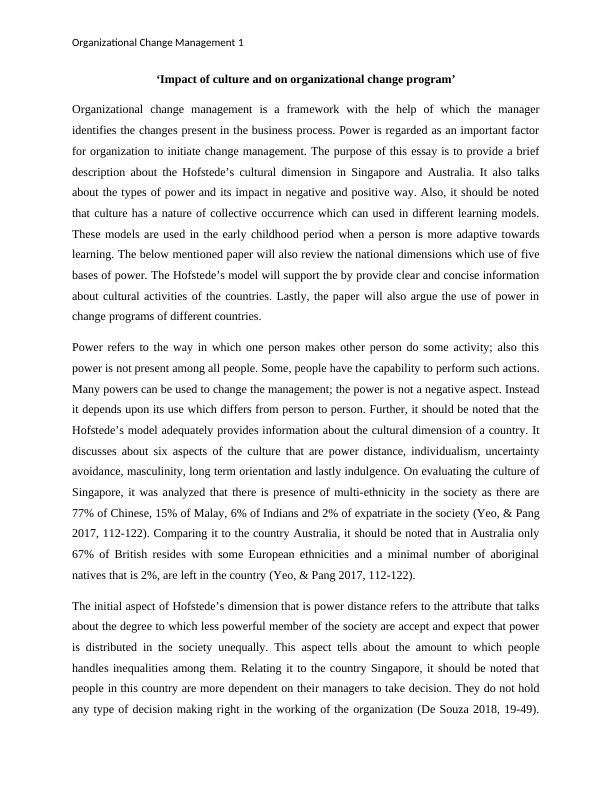Organizational Change Management
Added on 2021-04-17
8 Pages3056 Words31 Views
Running Head: Organizational Change ManagementOrganizational ChangeManagement

Organizational Change Management 1‘Impact of culture and on organizational change program’Organizational change management is a framework with the help of which the manageridentifies the changes present in the business process. Power is regarded as an important factorfor organization to initiate change management. The purpose of this essay is to provide a briefdescription about the Hofstede’s cultural dimension in Singapore and Australia. It also talksabout the types of power and its impact in negative and positive way. Also, it should be notedthat culture has a nature of collective occurrence which can used in different learning models.These models are used in the early childhood period when a person is more adaptive towardslearning. The below mentioned paper will also review the national dimensions which use of fivebases of power. The Hofstede’s model will support the by provide clear and concise informationabout cultural activities of the countries. Lastly, the paper will also argue the use of power inchange programs of different countries. Power refers to the way in which one person makes other person do some activity; also thispower is not present among all people. Some, people have the capability to perform such actions.Many powers can be used to change the management; the power is not a negative aspect. Insteadit depends upon its use which differs from person to person. Further, it should be noted that theHofstede’s model adequately provides information about the cultural dimension of a country. Itdiscusses about six aspects of the culture that are power distance, individualism, uncertaintyavoidance, masculinity, long term orientation and lastly indulgence. On evaluating the culture ofSingapore, it was analyzed that there is presence of multi-ethnicity in the society as there are77% of Chinese, 15% of Malay, 6% of Indians and 2% of expatriate in the society (Yeo, & Pang2017, 112-122). Comparing it to the country Australia, it should be noted that in Australia only67% of British resides with some European ethnicities and a minimal number of aboriginalnatives that is 2%, are left in the country (Yeo, & Pang 2017, 112-122). The initial aspect of Hofstede’s dimension that is power distance refers to the attribute that talksabout the degree to which less powerful member of the society are accept and expect that poweris distributed in the society unequally. This aspect tells about the amount to which peoplehandles inequalities among them. Relating it to the country Singapore, it should be noted thatpeople in this country are more dependent on their managers to take decision. They do not holdany type of decision making right in the working of the organization (De Souza 2018, 19-49).

Organizational Change Management 2This activity is initiated because the majority population of the country is Chinese who believesin Confucian teachings. Whereas talking about Australia, it should be noted that power distanceindex in the country relatively high which states that people in this country do not strive for theorganizational rights. Further, as there is prevalence of flat organizational structure in the countrywhich makes it easier for people to directly their manager to solve the issue (Comber 2015, 362-367). The next dimension is the individualism versus collectivism (IDV) dimension which talks aboutthe degree to which people in a country prefer taking care of only themselves and theirimmediate families in the society. The features of collectivism talks about the preference ofpeople in the society to care for their relatives and other members in a group and provide themunquestioning loyalty as well (Ferraro, & Briody 2017). The loosely knit group talks in thelanguage of ‘I’ and the tightly knit groups talks in the language of ‘We’. Further, in the countrySingapore, people do care for their large extended family; they rely on them as well. They scorevery low in this frame as they believe in initiating activities together. Contradicting to the case inAustralia, people in this country share the feeling of individualism and only care for theirimmediate family and themselves. These people are self-reliable do not prefer depending onsomeone for their cost of living or emotional support. People of Singapore are regarded ascollectivist whereas Australians are called individualists (Caleon, et. al. 2015, 925-942). Masculinity refers to the dimension that represents a preference in the society for heroism,monetary rewards and achievement in the society. And on the other hand, femininity stands forthe preference for co-operation, modesty and caring in the society. The two aspects contradict totheir works, as masculinity talks about the quantitative growth whereas femininity talks aboutquality of life. Many times this aspect is also related to tough versus tender. Further, Singaporescores 48 in this case which means that the society is little more inclined towards femininitywhereas in the case of Australia, the score is 61. It states that the country is dominated by malesection of the society (Oc, et. al. 2015, 68-80). Uncertainty avoidance refers to the way in whichsociety coupes with the upcoming contingent situations. It talks about the ways in which peopletackle with unknown situations coming on their way. The country Singapore scores 8 in this casewhere as Australia score 51 (Prado, et. al. 2014, 420-428). The score 8 states that the countryfully abides the rules and regulations formed for their betterment. Further long term orientation

End of preview
Want to access all the pages? Upload your documents or become a member.
Related Documents
[PDF] Organizational Change Management Assignmentlg...
|8
|2787
|76
Impact of country’s culture in use of power to initiate change programlg...
|8
|2883
|176
Organizational Change Management: Doclg...
|8
|2858
|65
Organizational Change Management Assignmentlg...
|8
|2647
|61
Organizational Change Management: A Comparison between Singapore and Australialg...
|12
|2338
|186
Organizational Change Management Assignment PDFlg...
|13
|3395
|104
